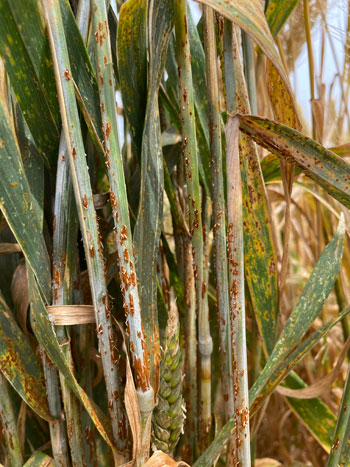Key points
- The Australian Cereal Rust Control Program has delivered more than 2000 wheat and barley rust resistance donors to Australian breeding programs
- New two-gene wheat stock combines two unique resistance genes that have never been defeated by stem rust
The delivery of durable rust resistance saves wheat and barley growers more than $1 billion each year.
Rusts are among the most destructive of all pathogens and pests of cereals. In fact, a recent study rated stripe rust and leaf rust of wheat among the five most-destructive pathogens and pests of all major food crops globally.
In Australia, wheat and barley varieties with genetic resistance to rust have delivered annual savings of about $1.1 billion by reducing yield loss and fungicide costs.
This achievement has been driven by the Australian Cereal Rust Control Program (ACRCP), which is a partnership between CSIRO and the universities of Sydney and Adelaide. It has delivered knowledge, germplasm and tools to cereal breeders, as well as information and management tools to growers.
The GRDC-invested program provides durable protection from both endemic and exotic cereal rust diseases. The ACRCP integrates information on rust pathogens with efforts to discover and introduce new rust resistance that can be used by breeders.
Over the past eight years, the ACRCP has developed and delivered more than 2000 wheat and barley rust resistance donors and molecular markers for 33 rust resistance genes in wheat and barley, which underpin breeders’ efforts to incorporate resistance to rust diseases in these crops.
Wheat resistance
Two important sources of rust resistance that have been introduced and used in Australian wheats are known as the Lr37/Yr17/Sr38 ‘VPM’ resistance (present in more than 50 wheat varieties) and the Lr24/Sr24 resistance (in more than 60 varieties).
Both of these resistances came from grassy relatives of wheat and have provided the Australian wheat industry with effective protection for decades.
Another outstanding source of resistance, the gene Sr26, was first transferred to wheat from the grass Thinopyrum ponticum in Canada in the 1930s. It has since been used in more than 30 Australian wheat varieties and is one of the few resistance genes that have never been defeated by stem rust.
To minimise the likelihood that this spectacular resistance gene might eventually be overwhelmed by a new virulent strain of stem rust, researchers identified the equally robust Sr61 gene (formerly SrB) in a South African wheat carrying a Thinopyrum chromosome.

Stem rust on wheat, which can cause total crop failure, has been well controlled for many years in Australia by the use of genetic resistance, saving the Australian grains industry an estimated $438 million a year. Photo: Dr Grant Hollaway
Crosses were made in the mid-1990s in the hope of replacing the Sr26 in locally adapted wheat with the new Sr61 gene. A recombinant line was produced but at that stage researchers did not know if it carried Sr26 or Sr61.
Some 15 years later, when Ug99 stem rust pathotypes threatened global wheat production, the recombinant seed was retrieved from storage and sent to the University of Sydney to verify the resistance present. Remarkably, it appeared the two genes, Sr26 and Sr61, had been combined.
A concerted effort by ACRCP team members at CSIRO and the University of Sydney led to the world-first isolation of both of these resistance genes and confirmation that the stock generated in 1996 indeed carried both Sr26 and Sr61.
This work has led to the discovery and characterisation of these two important stem rust resistance genes, which have now been combined in such a way that they will not separate during normal wheat breeding or cultivation activities. This new two-gene stock, which will be much less prone to being overcome by changes in the stem rust pathogen, has been made available to Australian wheat breeders.
Barley
Our research on rust resistance in barley has focused mainly on leaf rust, the most common and damaging rust disease on barley worldwide – estimated to cause some $21 million in annual losses in Australia.
To date, this has led to the discovery and/or characterisation of eight leaf rust resistance genes in barley, and the development of high-throughput markers for six important resistances including the durable adult plant resistance (APR) genes Rph20, Rph23 and Rph24.
The markers for the APR genes are particularly important as these are the first genes conferring this type of resistance to be characterised in barley. The markers allowed the additivity of these durable genes to be proven, meaning that combining two or more gives higher levels of resistance.
The markers also allowed confirmation of the presence of these APR genes in Australian barley varieties. For instance, Flagship and Barque carry Rph20, while Oxford and Starmalt carry both Rph20 and Rph24 – and they have greatly enhanced efforts to identify new uncharacterised sources of APR to leaf rust by focusing efforts on lines that lack the three genes and yet show APR.
More information: Dr Ian Dundas, 08 8313 3307, ian.dundas@adelaide.edu.au

























































